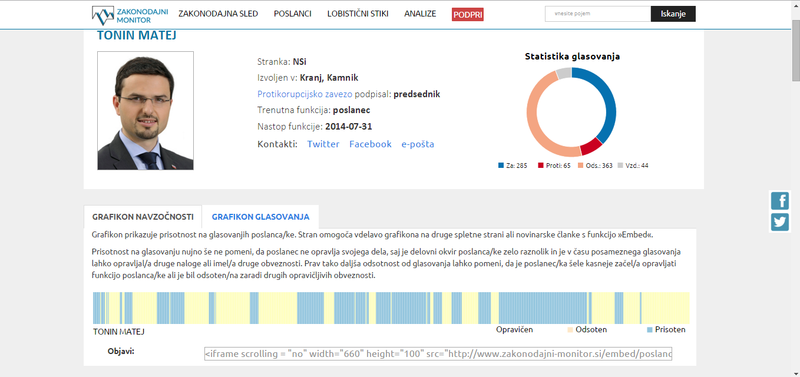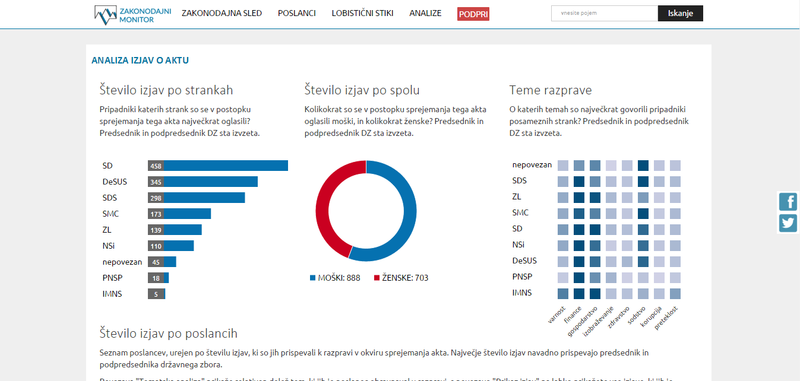OpenGov Voices: The first step toward Slovenia’s legislative footprint

The term “legislative footprint” 1 has become a popular new concept surrounding transparency of the legislative process and supervision of lobbying in public decision-making. But the world has not yet seen a comprehensive, real life, IT-supported legislative footprint in practice. In the beginning of 2015, Transparency International Slovenia launched an innovative project with a vision to combine multiple databases into one holistic tool, illustrating a complete legislative footprint. The aim is to offer a user-friendly view into decision-making processes, from the moment the government starts to prepare an act all the way through the legislative process in the National Assembly. This will be enriched with reported lobbying contacts as well as data visualization of bills and their changes through time.
The platform Zakonodajni Monitor (“Legislative Monitor”), created by Transparency International Slovenia, Institute Jožef Stefan and virostatiq.com, is a civil society project that will provide greater insight into the adoption of legislation, representing the first step in establishing a comprehensive legislative footprint. The first step was to establish a solid foundation for further upgrades of the platform. At this moment the platform combines:
- A database of adopted legislation in the National Assembly
- Reported lobbying contacts (already partially presented in previous blog post)
- Adoption of legislation processes (legislative procedure phases) — including parliamentary discussions and votes — and data about members of National Assembly
- Analyses of data and data visualizations.
Within Zakonodajni Monitor, you’ll find a host of information on legislative acts, such as insight into the process of its adoption; some basic information about the act; a timeline of legislation process and voting; proposed amendments; as well as analyses of parliamentary discussions and voting for each proposed amendment and the act as a whole, where votes are displayed by single members of National Assembly and also by electoral units and deputy groups. The central visualization is a timeline of each single act. Currently, we are only showing timelines of legislation processes in the National Assembly due to the unavailability of data from the procedure in the government.

The second part of the platform contains information about members of the National Assembly. This section provides data on the statistics of voting, attendance of the legislators and voting per single act. It facilitates comparability of data about voting on the individual cases and reported lobbying contacts.
In addition, the platform provides 3 visualizations of data, namely analyzation of voting, presence and the hierarchically groupings of MPs based on voting.
Under the hood
The platform partly uses the MEAN stack, a Node.js/Express server with MongoDB database, but without the Angular frontend. The graphics in the frontend are handled with D3 (charts) and Sigma.js (networks) libraries. In the server, we use a number of advanced machine-learning technologies (NLP, k-means clustering, statistical classifiers) for making sense of the collected data.
Data are collected separately from several online and offline sources, then aggregated in a MongoDB database with several tables. A drawback of the Java data collection module is its heavy reliance on the availability of online data sources, which is inevitable as the state doesn’t provide automated data interfaces. To complete one round of data gathering, the module must visit in excess of 6,000 web pages, placing a heavy load on at least one of the three servers we use.

The platform provides great opportunities for upgrades but since the development of the platform depends on the availability of data provided by the government and courts, we are not able to show the entire legislative footprint. Namely, we are still in the process of obtaining a database of proposed legislation (95-97 percent of legislation is proposed by the government), court decisions, criminal statistics and inspection statistics. Also, systemic changes are needed to obtain these data and provide sufficient transparency into the legislative process and decisions, external influences where there is a high risk of political corruption.
The platform is meant to be used by active citizens, policy researchers, think tanks, NGOs, CSOs and journalists to access and use collected data for evidence-based advocacy, enabling them to be effective watchdogs over the legislative process. Stakeholders can hold decision-makers on all levels of the legislative process accountable with this tool. The platform enables effective policy change and system reform. TI Slovenia held training for journalists on how to use the platform, and it is garnering significant media attention.
1 Definition of legislative footprint as used in this project: consists of a list of laws, including act name, EPA registration number, the current phase of the legislative process the act is in and whether there has been a breach of resolution on normative activities (this represents a minimum standard of public consultation and openness of the legislative process, as it requires a minimum 30-day public debate on all new legislation). Great emphasis is given to the external/lobbying influences to the adopted decisions. (Return to top)
Interested in writing a guest blog for Sunlight? Email us at guestblog@sunlightfoundation.com

